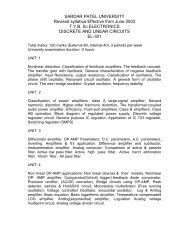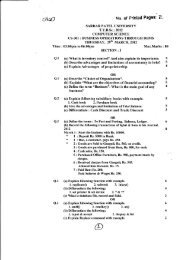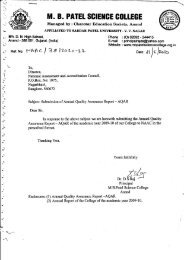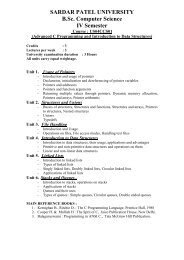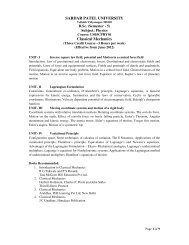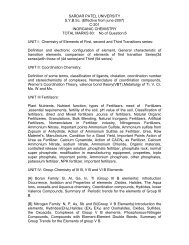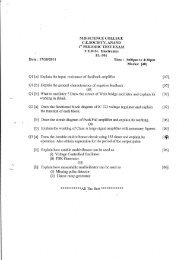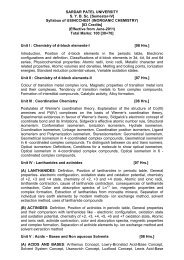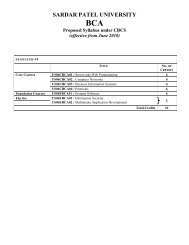B.Sc. Computer Science VI Semester - MB Patel Science College
B.Sc. Computer Science VI Semester - MB Patel Science College
B.Sc. Computer Science VI Semester - MB Patel Science College
You also want an ePaper? Increase the reach of your titles
YUMPU automatically turns print PDFs into web optimized ePapers that Google loves.
Course : US06CCSC02(Relational Database Management System)Credits : 3Lectures per week : 3University examination durationAll units carry equal weightage.: 3 HoursUnit 1 : Relational Database Theory and Data Modeling− The three-schema architecture for a Database Management System (DBMS)− Introduction to data models (hierarchical, network, relational)− Examples of current RDBMS products− The relational data model: concepts and terminology, operations on data (DDL,DML), relationships and relationship types− Integrity constraints− Codd rules− Entity-relationship modeling (different types of entities, attributes, relationshipsand their representation in the E-R diagram)− Case studies of data modeling using E-R modelingUnit 2 : Introduction to SQL− SQL - introduction , advantages and disadvantages− Data types – built-in (number, char, varchar2, date, raw, long raw)− Types of SQL Statements : DDL (Data Definition Language), DML (DataManipulation Language), DCL (Data Control Language), TCL (TransactionControl Language)− Working with SQL*Plus – overview and basic commands like ed, start, get, save,exit, connect, set linesize, set pagesize and host− Creating table and inserting data - CREATE TABLE, INSERT, retrieving datausing query – SELECT , manipulating data – DELETE and UPDATE , modifyingand removing table – ALTER TABLE and DROP TABLE.− Pseudo columns – ROWID, ROWNUM, USER, UID, SYSDATEUnit 3 : Data Constraints and Functions− Null values, TAB table, DUAL table− Operators – arithmetic, relational, logical, range searching, pattern matching andset− Data constraints – Introduction, advantages and disadvantages− Type of data constraints – NOT NULL, UNIQUE, PRIMARY KEY, FOREIGNKEY and CHECK− Modifying constraints, working with data dictionary and use ofUSER_CONSTRAINTS− Functions – introduction, merits and demerits, types of functions (scalar andaggregate)− <strong>Sc</strong>alar : Numeric functions (ABS, FLOOR, MOD, POWER, ROUND, SIGN,SQRT and TRUNC), Character functions (CHR, ASCII, CONCAT, INITCAP,LOWER, SUBSTR,TRIM, UPPER), Date functions (ADD_MONTHS,LAST_DAY, NEXT_DAY, MONTHS_BETWEEN), Conversion functions(TO_NU<strong>MB</strong>ER, TO_CHAR and TO_DATE)
Course : US06CCSC03(Web Designing and Applications)Credits : 3Lectures per week : 3University examination duration : 3 HoursAll units carry equal weightage.Unit 1. The Internet and Features of Popular Internet Browsers- Introduction to the Internet- History of the Internet- Services provided by the Internet- Some basic terminology and concepts (WWW, URL, webpage, web site, webservers, web browsers, HTML, search engines, etc.)- Components of a browser window- Use of menus and toolbar buttons- History and navigation- Setting basic options, security and privacy precautions- Managing bookmarks/favorites- Tabbed browsing, downloading files, saving web pages for offline readingUnit 2. Web Page Designing, Frames and Forms- An introduction to HTML- HTML tags- Structure of an HTML document- Text and paragraph formatting- Ordered and unordered lists, nested lists- HTML tables- Links- Images- Frames, framesets, nested framesets- Designing HTML forms- Webpage layoutUnit 3. Client side scripting- Introduction to client side scripting- Example of client side scripting- Importance and data validation- Control structure- Event handlingUnit 4. Server side <strong>Sc</strong>riptingIntroduction to serverside scriptingNeed of server side scriptingIntoduction to objects:application,sessionCookies,Connectivity with DatabaseConnection,recordset,request,responseMethods of objectsTEXT BOOKS:1. Ivan Bayross, “Web Enabled Commercial Applications Development usingHTML, DHTML, Javascript, Perl CGI”, BPB, 20042. Douglas E Comer: The Internet, PHI, Second Edition,May 20003. Xavier C : World Wide Web Design With HTML, Tata McGraw Hill Publication,20004. Manuals of suitable packages
Course : US06CCSC04(Introduction to Microprocessors and Assembly Language)Credits : 3Lectures per week : 3University examination durationAll units carry equal weightage.: 3 HoursUnit 1 : Assembly Language Terms & Directives− Microprocessor evolution− The 8086 microprocessor family overview− 8086 internal architecture : the execution unit, the bus interface unit− Overview of 8086 register set− The concept of assembler− Assembly language requirements : Assembly Language, Identifier, Statements &Directives.− Assembler Directives : Assume, db, dd, dt, dw, end, endp, ends, extm, label, proc,ptr, public, segment, offset, model, include, equ.Unit 2. Assembly Language Instructions – I− Arithmetic Instructions : ADD, ADC, INC, SUB, DEC, CMP, MUL, IMUL, DIV,IDIV, NEG− Data Transfer Instructions : MOV, XCHG, LEA− Logical instructions : AND, OR, NOT− Rotate and shift instructions : ROL, ROR, SHL, SHRUnit 3. Assembly Language Instructions – II− Unconditional & conditional JUMP instructions− Unconditional & conditional LOOP instructions− String Instructions : REP, REPE, REPNE, MOVS/MOVB/MOVSW, COMPS/COMPSB/SOMPSW, SCAS/SCASB/SCASW, LODS/LODSB/LODSW, STOS/STOSB/STOSW− Processor Control Instructions : ST, CLC, CMC, STD, CLD, STI, CLI, NOPUnit 4. 8086 Programming Using Assembly Level Language− The structure of a typical assembly program.− Implementation of control structures : IF-THEN, IF-THEN-ELSE, MULTIPLEIF-THEN-ELSE.− Implementation of looping structures : WHILE-DO, REPEAT-UNTIL.− Programming based on Units 2 to 5.TEXT BOOKS :1. Douglas V. Hall : Microprocessor and Interfacing programming and Hardware,Tata McGraw-Hill, 2003.2. Abel P. : IBM PC Asembly Language and Programming, 5 th edition, Prentice-Hall of India Pvt. Ltd., 20013. B. RAM “Fundamentals of Microprocessor and Microcomputers”, Dhanpat RaiPublications4. Walter A. Triebel and Avtar Singh, “The 8088 and 8086 Microprocessors –Programming, Interfacing, Software, Hardware and Applications”, PHI Prentic-Hall
Course : US06CCSC05(Software Engineering)Credits : 3Lectures per week : 3University examination durationAll units carry equal weight age.: 3 HoursUnit 1 : Introduction− Introduction : Software and Software Engineering− General Characteristics of Software Process− Phases in Software development− Effort and Error Distribution− Process Models : Waterfall, Prototype, Iterative enhancement, spiral− Software metrics : introduction, product metrics, process metricsUnit 2 : Requirement Specification and Software Project Planning− Introduction : Software Requirement Specification (SRS) and Needs− Problem Analysis - Structuring Information− Introduction to UML− Software Requirement Specifications (SRS), Characteristics and Components ofSRS− Specification language (Structured English, Regular Expression and DecisionTable)− Structure of SRS, Validation of SRS− Introduction: Software Projects, Planning, Categories of Software projects− Overview of Cost estimation, Uncertainty in cost estimation, size estimation,COCOMO Model (with example)− Project Monitoring Plan : Time sheets, Reviews, Cost- schedule milestone andEarned value method− Software Quality Assurance Plans (SQAP)− Overview of Risk ManagementUnit 3 : System Design− Introduction : System Design− Design Objectives and Design Principles− Design Concepts - Top down and Bottom up approach, Problem Partition,Abstraction, Modularity, Module Level concept, Coupling, Cohesion− Overview of structured design− Function v/s Object Oriented approach− Design Specification, Verification− Introduction: Detailed Design− Module Specification, Desirable properties, functional module specification, Dataabstraction specification− PDL, Logic/ Algorithm Design− Design Verification – Design Walkthrough, Critical Design review, ConsistencycheckersUnit 4 : Coding and Testing− Introduction: Coding, Top Down and Bottom Up approach for coding− Structured programming, Information Hiding
− Programming style, Internal documentation− Verification (code reading)− Introduction : Testing, Error, Fault, Failure & Reliability− Testing process, Top down and bottom up approach for testing− Levels of Testing− Functional Testing v/s. Structural testingTEXT BOOKS :1. An Integrated Approach to Software Engineering : By Pankaj Jalote, NarosaPublishing House, Second Edition,19972. Software Engineering a practitioner’s approach : By Roger S. Pressman, TataMcGraw- Hill, 5th EditionREFERENCE BOOKS :1. Software Engineering Fundamentals, By Richard Fairley, Tata McGraw HillSoftware Engineering By Ian Somnmerville, Addition- Wesley, 5th Edition, 2000
Course : US06CCSC06(E-Commerce)Credits : 3Lectures per week : 3University examination durationAll units carry equal weightage.: 3 HoursUnit 1. Intranet and Extranet− Architecture of Internet,Intranet,Extranet− Charactristics of internet,Intranet and extranet− Application of Intranet− Application of extranetUnit 2. Introduction To E-Commerce− Definition, communication perspective, business process perspective, serviceperspective− Classification by nature of transaction : B2B, B2C, C2C, C2B, Non business EC,Intra-business EC− Classification of EC Applications: electronic market, inter organizational system,customer services− Benefits to organizations, consumers, and society− Limitations of EC, framework of EC, future of ECUnit 3. E-Commerce Business Models and Electronic Marketplaces− Introduction, eight key ingredients of a business model, major B2C and B2Bbusiness models, Introduction to M-Commerce.− Marketspace components, types of electronic markets (electronic storefronts,electronic malls, types of stores and malls)− Portals and their types, role of intermediaries in E-markets, E-market successfactors, competitive factors, impact of E-Market on organizations (marketing, HR,manufacturing, finance and accounting)Unit 4. Customer Relationship Management (CRM) and ElectronicsPayment system− CRM : meaning, types of CRM, benefits and limitations of CRM, issues in CRMimplementation, classifications of CRM applications, one-to-one marketing(personalization, collaborative filtering, customer loyalty, trust)− Security schemes− Electronic credit card system on Internet− Electronic fund Transfer and Debit card on internet− Smart card systemTEXT BOOKS :1. Electronic Commerce : A managerial Perspective Efraim Turban, Jae Lee, DavidKing, H Michael Chung (Pearson Education.)2. E-Commerce – Business, Technology, Society Kenneth C Laudon, Carol GuercioTraver (Pearson Education)
Course : US06CCSC07(Practical Based on US06CCSC01 & US06CCSC02)Credits : 3No. of laboratory hours per week : 6University examination duration: 3 HoursPart-I : Weightage-50%Practical based on US06CCSC01Part-II : Weightage-50%Practical based on US06CCSC02Course : US06CCSC08(Practical Based on US06CCSC03, US06CCSC04 & Project)Credits : 3No. of laboratory hours per week : 6University examination duration: 3 HoursPart-I : Weightage-30%Practical based on US06CCSC03.Part-II : Weightage-30%Practical based on US06CCSC04.Part-III : Weightage-40%Project



